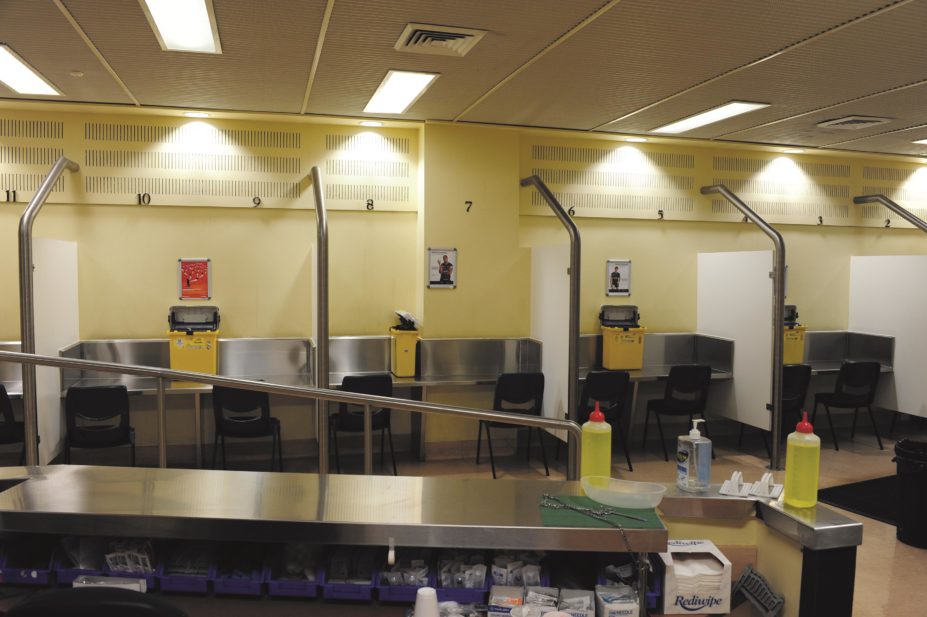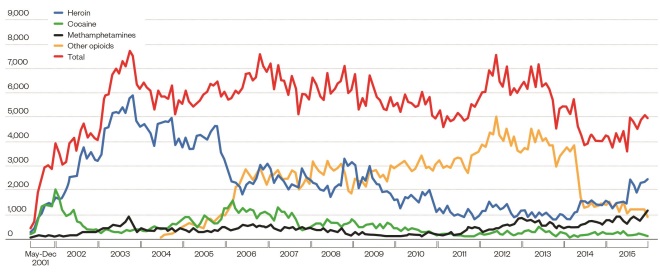
Uniting Medically Supervised Injection Centre
For the past 15 years, drug users living in Sydney, Australia, have had access to a safe place to inject their drugs. The drug consumption room (DCR), housed by the Sydney Medically Supervised Injection Centre (MSIC), is supervised by trained medical staff and provides clean syringes and medical care for anyone in danger of overdosing. Since it opened in May 2001, the New South Wales (NSW) government-backed service has had approximately 15,000 clients, and 500 of these were new registrations in 2015. Staff members have supervised close to 1 million injections, including more than 50,000 in 2015 – equivalent to an average of 147 injections per day. The centre is accountable to both the NSW health department and NSW police.
“The Sydney MSIC has managed more than 6,000 overdoses in 15 years of operation with zero fatalities,” says Sarah Hiley, the centre’s health education team manager. “We keep both injecting drug users and the community where they use safe.”
The MSIC has three separate areas and operates a one-way client flow. In the waiting room and assessment area, clients are assessed for eligibility to use the service. They are then directed to the injecting room, a clinical environment with a minimum of two trained staff (including a registered nurse) always on duty. Clients are given clean injecting equipment and are advised on safe injecting practices. The room has eight open booths that can seat two people, allowing staff to supervise at all times. Clients remain under observation in the aftercare area until they are ready to leave.
Anything is better than injecting behind a dumpster on a street and having people overdosing in the toilets of bus stations
The MSIC is one of a growing number of DCRs that have been set up in several countries in response to chronic drug addiction. The first of its kind opened in Bern, Switzerland, in 1986, where, along with Germany and the Netherlands, DCRs were scaled-up in the 1990s to ensure wider access to the facilities. In the early 2000s, DCRs opened in Sydney, and Vancouver, Canada. Spain, Luxembourg and Norway followed suit and there are now around 100 such supervised injection facilities (SIFs) in operation worldwide. In most countries, DCRs are located in the capital city or in specific regions, but the Netherlands and Switzerland provide nationwide coverage.
In the Republic of Ireland’s capital, Dublin, a city with a significant heroin problem that spans back several decades, there are thought to be around 400 drug users who inject in public[1]
. Figures from 2013 reported by Ireland’s National Drug Treatment Reporting System show that of the 15,000 people treated for problem drug or alcohol use in Ireland, around 4,000 reported an opiate as their main problem drug. Of these, over half were residents of Dublin.
Legislation is going through parliament that will allow the Sydney clinic to be emulated.
“Ignoring the problem is irresponsible and inhumane,” says Aodhán Ó’RÃordáin, a former minister of state for the Irish government’s Department of Health who was responsible for the National Drug Strategy. “Anything is better than injecting behind a dumpster on a street and having people overdosing in the toilets of bus stations.”
DCRs are not universally accepted, however. A recommendation from an independent drugs commission in 2013[2]
to open a DCR in Brighton, England, was shelved. Despite mounting evidence that they provide a much needed form of harm reduction to drug users, there are no further plans to open a DCR in the UK.
Reducing harm
The move away from criminalisation and the abstinence model of care towards harm reduction and low-threshold services grew in the 1980s thanks to pioneering drug and HIV workers who strived to prevent the rising numbers of drug-related deaths. The harm reduction approach became evident through needle and syringe exchange programmes, opiate substitution therapy and inpatient detoxification services that have little, if any, criteria for entry.
Globally, some 27 million people are problem drug users, and almost half inject drugs[3]
. According to the 2015 World Drug Report, risk factors, including the transmission of infectious diseases and drug overdoses, result in the death rate among people who inject drugs being 15 times higher than the rest of the population[3]
: the annual number of drug-related deaths was estimated at 187,100 in 2013.
Most of the 15 million people worldwide who are addicted to opioids use illicitly cultivated and manufactured heroin, but an increasing proportion use prescription opioids. Worldwide, an estimated 69,000 people die from opioid overdose each year, a figure that the creation of more DCRs could reduce.
“When registered clients arrive in our reception area they tell us what drug they are going to use that day and the last time they used a drug of that class,” explains Hiley. “We are looking at the risk of overdose. If someone hasn’t used in three days or longer we automatically think ‘right you are at a big risk of overdose’.”

Source: Sarah Hiley
Sarah Hiley, health education team manager at Sydney’s Medically Supervised Injection Centre, says the facility keeps drug users and the public safe
The three main aims of DCRs are to provide an environment for safer drug use, to improve the health of drug users, and to reduce public disorder. “The weight of these goals differs between countries,” explains Dagmar Hedrich, head of the health consequences and responses sector for the European Monitoring Centre for Drugs and Drug Addiction (EMCDDA). “In the Netherlands, for example, DCRs are more clearly identified as a means to keep neighbourhoods free of nuisance originating from public drug use, while in Spain they are more directly focused on improving the users’ health and safety situation.”
DCRs also provide users with the opportunity for referral to other health services. Staff at the MSIC have made more than 12,000 successful referrals in total, around half of which were for addiction treatment. In 2015, staff made 578 successful referrals to treatment and other social welfare services. Overall, the evidence is that DCRs facilitate, rather than delay, access to treatment for their clients[4]
.
Since the MSIC opened in 2001, the number of publicly discarded needles and syringes in Sydney’s Kings Cross area has halved, and there has been an 80% reduction in ambulance call-outs for overdoses during the centre’s opening hours. Similarly, in Vancouver, the opening of a DCR has resulted in a 35% fall in lethal overdoses in the area around the facility and it is estimated that the facility prevents between 2 and 12 cases of lethal overdose each year.
Frequent use of DCRs has also been linked with a 69% decrease in syringe sharing and regular use has been associated with increased requests for advice on safer injection practices[5]
.
Drug trends
Another benefit of DCRs is that trends in local drug use can be monitored and responded to. “The substances injected [at Sydney’s MSIC] have changed quite dramatically in 2015,” explains Hiley. Between 2001 and 2006, heroin was the most injected drug at the MSIC, but between 2006 and 2014, pharmaceutical opioids (Oxycontin and MS Contin) had overtaken heroin as the most injected drugs at the centre. However, in 2014, reformulated Oxycontin was introduced, which the manufacturer claimed was tamper resistant. This led to a drop in the use of pharmaceutical opioids and heroin rose to the top of the list again (see graph: Drug trends at Sydney’s supervised injection facility). In 2015, heroin made up 41% of all injections, followed by pharmaceutical opioids (27%), amphetamines (18%) and cocaine (3.5%). The remaining 10.5% comprised combinations of drugs or other drugs not listed.

Drug trends at Sydney’s supervised injection facility
Source: Uniting Medically Supervised Injection Centre, Sydney
Self-reported substances injected at Sydney’s Medically Supervised Injection Centre from 2001-2015
Hiley says the popularity of pharmaceutical opiates in Sydney is because of the cost of illicit drugs. “We have some of the most expensive illicit drugs in the whole world, which is why I think we have higher rates of injecting pharmaceutical tablets,” she explains.
“We are able to respond to changes in the drug trends quite quickly,” says Hiley. “[For example], when tablets became more and more popular to inject, we brought in wheel filters. If you put your tablet solution through a wheel filter you remove most of the particulate matter, therefore reducing the harms associated with injecting non-soluble particles into your body.”
It’s not sufficient to simply call for policy change; you need to take an active role in creating the environment for that change
Breaking down barriers
The contribution that DCRs make to harm reduction has shielded them to some degree from legal challenges. The International Narcotics Control Board, an independent and quasi-judicial body that is responsible for monitoring governments’ compliance with the United Nations international drug control treaties, has been hostile to DCRs in the past. As recently as 2014, it highlighted its concerns, stating that “such facilities could be inconsistent with the provisions of the international drug control conventions”[6]
. However, when national courts in Germany, Switzerland, Australia and Canada have ruled on the legality of DCRs, there has been no prohibition[7]
.
DCRs in both Australia and Canada started out as trials with legal exemptions. The five DCRs in Denmark owe their existence and protected legal status to a mobile unit that originally acted outside the law for several months (without incurring any penalties) and resulted in politicians legislating for DCRs. “There is usually a lot of uncertainty and worry about [the opening of a DCR], so often they start out as a pilot,” explains Charlie Lloyd, a senior lecturer at the department of health sciences at the University of York. Lloyd is a former manager of an independent working group on DCRs established in 2004 by the Joseph Rowntree Foundation, a British social policy research and development charity, which advocated the opening of pilot DCRs in the UK in 2006.

Source: University of York
Charlie Lloyd, a senior lecturer in health sciences at the University of York, argues that it is a small step to provide an injecting facility at needle exchange services
Lloyd acknowledges that there is little political will in the UK to open a DCR. However, he sees two pathways by which one could become a reality: “The local pathway, whereby a very brave chief constable and police and crime commissioners say ‘yes, we have a serious problem with overdose deaths and injecting in public places and we need to do something about it’ or through enabling legislation at government level.” Lloyd believes this is much more likely to be pushed through at a local level, rather than through central administrations.
The Ana Liffey Drug Project, a national addiction service in the Republic of Ireland, has been lobbying for SIFs since 2012. Marcus Keane, its head of policy and advocacy, says the introduction of SIFs as a harm reduction approach requires tenacity and a lot of work. “It’s not sufficient to simply call for policy change; you need to take an active role in creating the environment for that change,” he says.
Support from several civil society actors drove the proposals for the Dublin DCR forward. “We were fortunate to have the support of the Voluntary Assistance Scheme of the Bar of Ireland, a group of barristers who gave very generously of their time, pro bono, to draft the legislation,” Keane explains. “We also had the support of a political champion in Aodhán Ó’RÃordáin, and civil servants in the Department of Health were very supportive.”
However, in Dublin, legislative change was not the only obstacle to the introduction of a DCR. “There’s always going to be dissenting voices, which is a good thing,” says Keane. “Generally, they have manifested themselves not as opposed to SIFs per se, but rather to spending scarce resources on SIFs when we could be spending funds elsewhere in the addiction sector, like on treatment beds.”
But Keane argues that SIFs are cost effective. “We’re already spending money on treating overdose, on ambulance call-outs, on emergency department attendances and so on; all the research on SIFs shows that they provide cost benefits as an intervention. Second, it’s not an either/or argument. We don’t need SIFs or residential treatment; we need both.”
When someone accesses a service like a SIF, there should be opportunities for them to access other higher threshold services, like stabilisation or detoxification services, with clear referral pathways
A local solution for a local problem
Injecting drug users in the UK, of which there are thought to be over 300,000[8]
, already access harm reduction services through needle exchange programmes. But while clean injecting equipment is provided, drug users may then leave to inject in a nearby garden or public toilet. Such injecting practices are often rushed because of fear of disturbance from police or passers-by, increasing the likelihood of an injury. Also, this practice means equipment is more likely to be reused, raising the risk of the transmission of infectious diseases. Because they feel isolated, this type of drug user may be less inclined to test for blood borne viruses, to seek medical help for ulcers or to enquire about treatment options.
“Our logic was that it was actually a rather small step to say ‘let’s provide an injecting facility at the needle exchange’,” says Lloyd, who argues that DCRs need to be located within already established drugs markets. “By the time [heroin users] are buying their drugs, they are usually pretty desperate to inject and they tend to use close by in public spaces,” he adds.
DCRs can be co-located with other services, or they can be specialised or mobile. But critics say that putting them in the same place as services that provide detoxification and treatment will expose clients to the lifestyle they are trying to leave behind. “There’s no necessity for SIFs to be in the same physical location as, for example, detoxification services,” says Keane. “What’s important is that SIFs are embedded into broader service delivery. When someone accesses a service like a SIF, there should be opportunities for them to access other higher threshold services, like stabilisation or detoxification services, with clear referral pathways.”
Although progress has been made, Keane says Dublin is still some way off from seeing such a centre open. “The law has to change first, then there will most likely need to be a licencing, and potentially planning, process before any SIF service could open its doors in Dublin,” he explains.
“We had to be clear that it was an injecting centre and not centres and it would be in a city centre location,” says former minister Ó’RÃordáin. “Every city is different with a different history of drug use. The location will be crucial, as will the interactions with the police.”

Source: Flickr / The Irish Labour Party
“Anything is better than injecting behind a dumpster on a street and having people overdosing in the toilets of bus stations,” says Aodhán Ó’RÃordáin, a former minister in the Irish government who was responsible for the National Drug Strategy
In Hamburg, Germany, local authorities took a different approach and aimed to decentralise drug users by establishing DCRs in areas where there were no open drug scenes. However, the EMCDDA notes that ‘decentralised’ DCRs have not countered public nuisance problems resulting from open drug scenes and their use is low compared with those located in city centres[9]
.
Opportunity for evidence
When a DCR does open in Dublin, it is critical that it is thoroughly evaluated, says Keane. “Ideally there will be independent and robust evaluation carried out. SIFs are a new departure for drug policy in Ireland – it’s important to know that they are doing what they are intended to do, and to add to the international research literature in the field,” he says. “As it stands, the evidence is that SIFs would be a good intervention for the problems we have; if this is not borne out by the research evidence when they are evaluated here, then obviously we should look at other options.”
According to Public Health England, individuals are most likely to start using drugs in their late teens and early 20s and will, on average, seek treatment within around eight years
[10]
. While every effort needs to be made to shorten this time frame, harm reduction is crucial until treatment is accessed. DCRs can provide some of that protection and help people into treatment sooner. In Europe, initiatives to introduce DCRs have not been as rigorously evaluated as their North American and Australian counterparts, meaning that trends in local drug consumption are being missed. The Republic of Ireland has an opportunity to address this shortcoming and to generate the evidence base around DCRs that will be needed to support their wider introduction.
Tony Duffin, director of the Ana Liffey Drug Project, says that since the charity began lobbying for SIFs in 2012, people have continued to die of overdose in the public domain. “I can’t help but think that if they had been in a SIF on those occasions they may not have died and could still be alive today. It’s important to remember that we can’t rehabilitate someone who is dead.”
- This article was amended on 17 June 2016 to correct a quote from Charlie Lloyd. It was also amended on 15 August 2016 to correct the number of new registrations to the NSW service in 2015 and the reduction in ambulance call-outs.
References
[1] Holland K. Dublin’s heroin problem. Irish Times. 13 April 2016. Available at: http://www.irishtimes.com/news/ireland/irish-news/dublin-s-heroin-problem-1.2608877
[2] Independent Drugs Commission for Brighton & Hove. Safe in the city. Brighton & Hove Community Safety Partnership. April 2013. Available at: http://www.safeinthecity.info/sitc-document/independent-drugs-commission-final-report-april-2013
[3] United Nations. 2015 World Drug Report. New York: United Nations Office on Drugs and Crime. Available at: https://www.unodc.org/documents/wdr2015/World_Drug_Report_2015.pdf
[4] EMCDDA. Drug consumption rooms: an overview of provision and evidence. European Monitoring Centre for Drugs and Drug Addiction. 2015. Available at: http://www.emcdda.europa.eu/topics/pods/drug-consumption-rooms
[5] Potier C, Laprévote V, Dubois-Arber F et al. Supervised injection services: what has been demonstrated? A systematic literature review. Drug Alcohol Depend 2014;145:48-68. doi: 10.1016/j.drugalcdep.2014.10.012
[6] INCB. Report of the International Narcotics Control Board for 2014. United Nations 2015. Available at: www.incb.org/documents/Publications/AnnualReports/AR2014/English/AR_2014.pdf
[7] Schatz E & Nougier M. Drug consumption rooms: evidence and practice. London: International Drug Policy Consortium. 2012. Available at: http://www.drugsandalcohol.ie/17898/1/IDPC-Briefing-Paper_Drug-consumption-rooms.pdf
[8] United Kingdom: High-risk drug use. United Kingdom country overview: A summary of the national drug situation. European Monitoring Centre for Drugs and Drug Addiction. Available at: http://www.emcdda.europa.eu/countries/united-kingdom
[9] Hedrich D. European report on drug consumption rooms. European Monitoring Centre for Drugs and Drug Addiction. 2004. Available at: http://www.emcdda.europa.eu/attachements.cfm/att_2944_EN_consumption_rooms_report.pdf
[10] Public Health England. Adult substance misuse statistics from the National Drug Treatment Monitoring System (NDTMS) 1 April 2014 to 31 March 2015. Available at: http://www.nta.nhs.uk/uploads/adult-statistics-from-the-national-drug-treatment-monitoring-system-2014-2015.pdf

